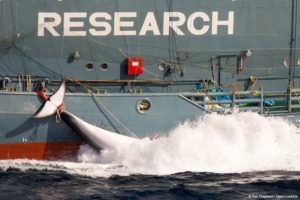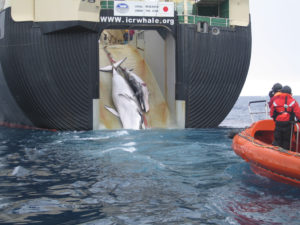Most divers have heard of Japan’s Okinawa Island and Iceland’s Silfra Fissure. Norway has also become a recent hotspot for in-water orca encounters. However, especially in light of recent news that Japan plans to resume commercial whaling and withdraw from the International Whaling Commission (IWC) to do so, should divers consider boycotting these whaling nations and take our business elsewhere? Japan, Norway, Iceland and the Faroe Islands continue to slaughter whales for various dubious reasons. Should this be an issue for divers? We each have an opinion, whether you consider whaling justified due to cultural symbolism or simply a barbaric ritual long-since outdated. Here we’ll discuss why you may (or may not) want to boycott modern whaling nations.
Whaling in Japan

BB tries to stop whale loaded on Nisshin.
© Sea Shepherd/Glenn Lockitch 2013
Before the IWC worldwide ban on commercial whaling came into effect in 1986, many countries, including the United States, hunted whales. Hunters sought sperm whales in particular for their meat, oil and bone. Japan remains by far, however, the world’s holdout when it comes to disregarding the whaling ban.
Japan never stopped hunting or killing whales. In fact, for many years the nation conducted commercial hunts in the northern Pacific and Southern Ocean under the cloak of “research.” In 2017, the Japanese fleet departed twice and slaughtered over 300 minke whales, 122 of which were pregnant and 114 of which had not reached maturity. Fin whales, sei whales and Bryde’s whales also fall victim during the annual season, albeit in smaller numbers.
Cultural significance of whaling in Japan
While whaling in Japan is doubtless alarming on many levels, whales have culturally been a food source there since at least 676 AD, when Buddhism considered the ingestion of land animals unfit. Therefore, hunters looked to the sea. By the Middle Ages, whale meat was highly prized.
As of today, minke whale populations are not threatened. The IWC has calculated that whaling fleets could take 2,000 minkes per year for 100 years without adversely affecting stocks of that particular species. Scientists estimate the Antarctic population to exceed 760,000 individuals and it has grown 9.5 times over the last century.
Modern Japan and whale meat

Image above: An adult and sub-adult Minke whale are dragged aboard the Nisshin Maru, a Japanese whaling vessel. The wound on the calf’s side was reportedly caused by an explosive-packed harpoon. This image was taken by Australian customs agents in 2008, under a surveillance effort to collect evidence of indiscriminate harvesting, which is contrary to Japan’s claim that they are collecting the whales for the purpose of scientific research.
In modern Japan, whale meat is sold to schools, hospitals and areas of deprivation because whale meat is now cheaper than ground beef. Overfishing, and the near-eradication of species such as bluefin tuna, has forced the Japanese government to organize marketing drives to promote the consumption of unpopular whale meat.
However, scientists have discovered high mercury levels in the meat, which can result in hazardous side-effects such as birth defects. This factor, combined with the mass-killing of juvenile and pregnant minke females in the Antarctic and North Pacific, makes the killing redundant in modern times. In terms of scientific value, in 2014 the Australian court ruled that Japan’s whale slaughter in the Antarctic violated the International Convention for the Regulation of Whaling. The convention stated that their actions were not ‘for purposes of scientific research,’ thus making their entire justification for whaling null and void.
Norway and Iceland
Until Japan decided to begin commercial whaling again, Norway and Iceland were the only countries in the world to officially endorse commercial whaling. While Japan claims to kill whales for research purposes. In the face of well-publicized opposition, Norway and Iceland both increased their quotas in 2018. This was despite multiple sources confirming that most of their populations despise whale meat. Additionally, Japan — the main importer of whale meat from Norway and Iceland — has reported warehouses of unused meat rotting away and refuse to purchase any more. In fact, the Norwegian government subsidizes the whale hunt and gave the industry $880,000 dollars in 2002 to dispose of excess whale blubber, which eventually made its way to dog food.
Whaling is a dying industry in Norway and Iceland where whaling boats have decreased from several hundred to a handful. With climate change causing whales to move further offshore in the search of krill, there may very well be no whale industry in future decades. But for now these three nations are steadfastly holding onto a fading tradition.
As divers, it’s up to each of us to decide if we want to avoid travel to these destinations. If you do forgo a trip to Norway, Iceland or Japan for this reason, make sure to let the operator that you would have dived with, or the hotel where you would have stayed, for example, know why you’re not coming. Change must come from within the populations themselves. Consequently, if other industries are losing money because of continued whaling, governments are far more likely to listen.
The post Should We Boycott Diving in Modern Whaling Nations? appeared first on Scuba Diver Life.
from Scuba Diver Life http://bit.ly/2SCYwPD
No comments:
Post a Comment